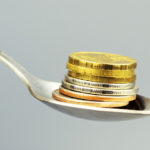Platinum vs palladium – dirty metal workers fight it out
(February 22, 2018 - by Adrian Holliday)
Rarer than gold, platinum and palladium are racing each other for price dominance. Both metals are heavily used with car catalysts, tasked to do the dirty job of filtering carbon monoxide emissions into something – water vapour, for instance – more environmentally–friendly.
And the auto-catalyst market, for the moment, appears massive: Asian vehicles sales are picking up speed as middle-class consumers flex their buying power.
While diesel vehicle sales in Europe are, yes, decelerating – traditionally diesel vehicles use large quantities of platinum in catalysts – car, van and lorry sales are up as the eurozone economy ticks higher (car sales in January climbed +6.8% according to the European Automobile Manufacturers Association).
Car and van sales are soaring in Europe as the eurozone area recovers: Shutterstock
Metal on metal price skirmish
At the start of this week the spot price of platinum was $1,009.00 per ounce while sister metal palladium was ahead at $1,048.25. That’s quite a turnaround for palladium. Since 2001 it was always the poorer sibling, price-wise. Why have palladium prices outperformed platinum?
“For a start,” wrote metals specialist Georgette Boele at ABN AMRO recently, “the decline of market share of diesel cars in favour of petrol cars has weighed on platinum prices and this has supported palladium prices. Moreover, palladium has a substantial supply deficit and this has bolstered prices.”
Fundamentals still shiny?
Boele concurs prices have been compromised over the VW dieselgate scandal – palladium spot prices dropped to under $500 in early 2016 – as car manufacturers increasingly take the electric vehicle (EV) fight to industry progenitor, Tesla.
Despite lying on pollution tests the VW Group looks set to retain its crown as the world’s biggest car group with 10.7m vehicles in 2017 predicted, possibly upping its lead over Toyota at 10.35m estimated.
But fundamentals for major auto-catalyst players – think BASF, Johnson Matthey, Clariant and Umicore – still look decent say some industry watchers. They also point to regulatory environmental pressure and stricter emission standards – Beijing is in the middle of a concerted $3bn pollution crack-down.
The future is electric, not diesel – which may weigh on platinum and palladium values: Shutterstock
Volatile and unloved?
Others are less enthused, pointing to a sector still fairly unloved and vulnerable to coal-face labour unrest and political blowback plus lurking low-to-mid level volatility.
UK-registered Lonmin, the third-biggest supplier of platinum with extensive operations in South Africa, has seen its share price (77.60p at time of writing) slip more than -40% in the past year though a +20% lift in the last six months points to on-going market gusts and squalls.
Lonmin came to global attention most forcibly in August 2012 during the Marikana miners’ massacre when 36 platinum miners were gunned down after protesting for a reasonable wage rise. That incident casts a long shadow for just-elected South African President, and multi-millionaire businessman, Cyril Ramaphosa, who failed to respond effectively to the tragedy at the time.
Johannesburg police officers drafted in to contain protesting crowds following the Marikana miners’ strike tragedy: Shutterstock
Could palladium’s strong run spell trouble?
If palladium’s stronger price performance continues, might that see the carmakers switch back to platinum? Quoted in the FT in late December, the industry-sponsored World Platinum Investment Council (WPIC) said it had “anecdotal evidence” carmakers were considering switching from palladium to platinum.
If so it “may have a considerable impact on short to medium-term platinum demand should it come to fruition”. Capital contacted the WPIC. Trevor Raymond, director of research, said a reversion to platinum might be more likely in the US and China markets dominated by petrol cars.
“Annual demand from autocatalysis is circa 8.4m ounces for palladium and 3.3m ounces for platinum so a small amount of strategic switching would result in material demand growth for platinum.”
Raymond also argues future automotive platinum demand could be higher as automakers are likely to keep a higher portion of diesel cars on Europe’s roads “to retain the CO2 benefit of diesel cars and avoid, already legislated, heavy CO2 fines”.
South African palladium mine workers get on with the job: Shutterstock
Long-term gleam?
But the longer-term auto-catalyst picture does not look so healthy. “Given the rise of EVs and subsequent strategy shift from car makers,” said commodity analysts from BMO Capital Markets in mid-February in a new report, “there is a school of thought that the demand outlook for auto catalysts is one in terminal decline.”
In the meantime, the Canadian financial services player says platinum’s got the edge. “The mood seems to be changing, and in recent weeks spot prices have closed the gap on palladium with the spread narrowing to within $10/oz."
"Fundamentally, with global auto sales growth slowing, and potential for platinum replacement in catalysts, we expect the average platinum price to be $50/oz higher than palladium this year."





